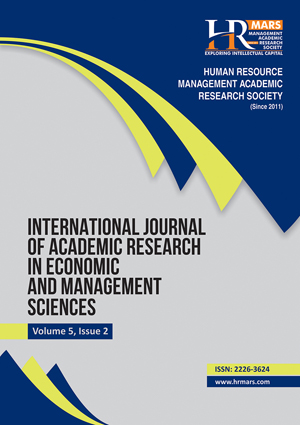
ISSN: 2226-3624
Open access
Fixed or floating exchange rate regime is one of dilemmas that arise between economic scholars and policymakers. Republic of Macedonia as a small opened economy has adopted the fixed exchange regime, but there are studies’ conclusions that the country pays considerable costs in maintaining the fixed exchange regime. Therefore the purpose of this research paper is to answer the question by an empirical analysis if Macedonia needs to maintain the fixed exchange regime or should change the regime to floating. To examine this, we analyze the effects of a range of macroeconomic variables such as real GDP, government fiscal balance, retail price index, trade openness, current account balance and monetary aggregates on the real effective exchange rate. In order to allow interaction between above variables a co-integration test has been done for ascertaining the short and long run relationship. Also the Granger Causality test has been applied to determine if causal relationship exists between variables. Based on vector error correction method (VECM) results, real GDP, trade openness, current account and monetary aggregates do not have significant effect on the real effective exchange rate in the long run. Regarding the retail price index and government balance are significant determinants in the short as well as long run dynamics. Thus, the empirical results reveal some relevant arguments that support the fix exchange regime.
Belke.A. & Zenki?.A. (2006), ‘Exchange Rate Regimes and the Transition Process in the Western Balkans’, Berlin, Germany, pg. 21.
Besimi F. (2009), ‘Monetary and Exchange Rate Policy in Macedonia’, Accession to the European Union-Lambert Academic Publishing, Germany.
Bogoev J. (2006), ‘Central Bank Independence, Transparency and Accountability-The Case of South East Europe’, M.Sc. Dissertation at Staffordshire University, UK.
Cîtu F. (2003), ‘A VAR Investigation of the Transmission Mechanism in New Zealand’, Reserve Bank of New Zealand
Disyatat P. (2001), ‘Currency Crises and the Real Economy: The Role of Banks. IMF, Working Paper No. 01/49, Internationally Monetary Fund
Egert B. & Macdonald R. (2006), ‘Monetary Transmission Mechanism in Transition Economies: Surveying the Surveillance’, Magyar Nemzeti Bank, MNB Working Paper, No. 2006/5.
Engle, R. F.; Granger, C. W. J. (1987). Co-integration and error correction: representation, estimation, and testing. Econometrica , 55, 251-276
Fetai B. (2011), ‘Exchange Rate Pass-Through in Transition Economies: The Case of the Republic of Macedonia’, William Davidsion Institute, Working Paper Number 1014, University of Michigan.
Gosh, Atish R., Anne-Marie Gulde, Jonathan Ostry, and Holger Wolf, 1997, „Does the Nominal Exchange Rate Matter?“ NBER Working Paper No. 5874
Granger, C. (1969). Investigating Casual Relationship by Econometric Models and Cross Sprectal Methods. Econometrica , 37, 424-458.
Husain, A.,Mody, A. and Rogoff, K. (2004), Exchange rate regime durability and performance in developing versus advanced economies (IMF and Havard University).
Jovanovic B. (2007), ‘The Fundamental Equilibrium Exchange Rate of the Denar’ Unpublished Master’s thesis, Staffordshire University: UK..
Jovanovic B. (2009), ‘Should the Macedonian Denar be Devaluated? Some Evidence from the Trade Equations’, South-East Europe Review 3/2009.
Jurgen Von Hagen and Zhow, J. (2002). “The Choice of Exchange Rate Regime: An Empirical Analysis for Transition Economies” ZEI working paper Germany
Krstevska A., Terzijan S., Stojanova B. & Besimi F. (2003), ‘Transmission Effect of the Exchange Rate for Monetary Strategy of the NBRM’, National Bank of the Republic of Macedonia, Economic Research No.II/2003
Levy-Yeyati, E. and Sturzenegger, F. (2000), „Classifying Exchange Rate Regimes: Deeds vs. Words,“ mimeo, Universidad Torcuato Di Tella, Buenos Aires.
Markiewicz, A. (2006) “Choice of Exchange Rate Regime in Transition Economies: An Empirical Analysis” Journal of Comparative Economics 34 (2006) 484 – 498.
Mishkin Frederic S. (2001), ‘The Transmission Mechanism and the Role of Asset Prices in Monetary Policy’, Working Paper 8617, National Bureau of Economic Research, http://www.nber.org/papers/w8617
McKinnon, Ronald, (1963), „Optimum Currency Areas,“ American Economic Review 53 (September): 717--725
Melvin, M. (1985), ‘Choice of an Exchange Rate Regime and Macroeconomic Stability’, in Journal of Money, Credit and Banking, 17:468-78.
Moosa, I.A. 2005. “Exchange Rate Regimes: Fixed, Flexible or Something in Between?,” London: Palgrave
Mundell, Robert, 1961, „A Theory of Optimal Currency Areas,“ American Economic Review 51 (September): 657--665
NBRM, Annual Reports, Published March –April 2005-2010
Nenovski T. & Makrevska E.(2009), ‘Influence of the Economic Crisis on the Exchange Rates of the Countries from Eastern and Central Europe’,Skopje 2009
(Sadiku et al., 2013)
Sadiku, M., Saliu, F., & Sadiku, L. (2013). An Empirical Analysis of the Exchange Rate Regime in the Republic of Macedonia. International Journal of Academic Research in Economics and Management Sciences, 2(6), 135–150.
Copyright: © 2018 The Author(s)
Published by Human Resource Management Academic Research Society (www.hrmars.com)
This article is published under the Creative Commons Attribution (CC BY 4.0) license. Anyone may reproduce, distribute, translate and create derivative works of this article (for both commercial and non-commercial purposes), subject to full attribution to the original publication and authors. The full terms of this license may be seen at: http://creativecommons.org/licences/by/4.0/legalcode